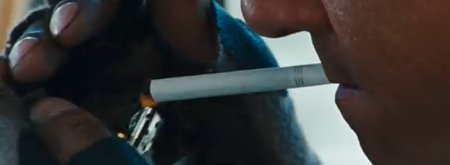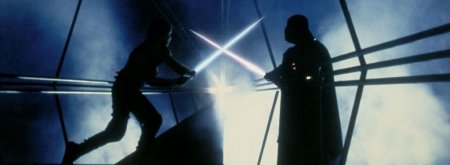The Hurt Locker
We imagine war is tough. We know it puts great strain on soldiers. But is war a drug? Even ‘the supreme drug of human existence’?[1] The Hurt Locker begins with this quotation from war correspondent Chris Hedges, and the narcotic addiction of battle is the film's central theme. Kathryn Bigelow directs masterfully, building tension both with unexploded ordnance and between the soldiers.
Loving the Bomb
We also know war is dangerous. As the film opens we begin to see just how deadly it is. The team have been sent to disarm a so-called improvised explosive device (IED) which has been discovered in a road, thinly disguised by plastic packaging. When the robot sent to detonate the bomb fails to get all the way, the team leader, Sgt. Thompson (Guy Pearce), dons the heavy bomb suit. As he approaches, another team member spots a man nearby with a mobile phone. But it's too late. He dials, and the bomb explodes, killing Thompson. Bigelow exposes us immediately to the suddenness of death in this environment. The suspense is carefully crafted. She decided to cast excellent but less-known actors as the three main parts so we would not pre-judge who would die. The IEDs are no respecter of persons or position.
That's just what their new team leader banks on. Sgt. James (Jeremy Renner) forgoes the protection of the robot on his first mission, striding towards an explosive device in the same suit in which his predecessor was killed. So is James a US Army fanatic, a patriot fighting for the forces of good against the axis of evil? Or is there something else about bomb disposal that drives James to act this way?
The Hurt Locker has received high praise from critics. It has a 97% positive rating on Rotten Tomatoes,[2] and Roger Ebert rates it ‘a leading contender for Academy Awards’.[3] In January 2010, it took the prize for best film at the Producers Guild of America awards.[4] Ebert is particularly positive about Jeremy Renner's Sgt. Will James, praising a performance that is ‘not built on complex speeches but on a visceral projection of who this man is and what he feels.’[5] This is the core of the film's success. In this film we feel like the fourth member of this three-man team. This intimacy is achieved through the extensive use of hand-held camerawork, under the direction of cinematographer Barry Ackroyd (United 93 and The Wind that Shakes the Barley). This gives the film a raw edge, putting us in the middle of the same tension as the soldiers. Screenwriter Mark Boal spent time shadowing an army explosive team, and no doubt some of the ambient tension in this film comes straight from his own experiences. This film also stands out because it's a war film that doesn't talk about The War. It doesn't critique the politics of the current Iraq conflict; its focus is firmly on this small group of experts and their deadly task.
James is clearly an expert at disarming bombs. He has defused nearly nine hundred in his career. One senior officer, congratulating him, asks, ‘What's the best way to defuse one of these things?’ James replied, ‘The way you don't die.’ This exchange encapsulates a great deal about James's character. First, he isn't flattered by Colonel Reed's praise. He is well aware (perhaps too aware) of how expert he is at disarming these devices, and this drives him to obsession. A complex car bomb outside UN headquarters is a puzzle to be solved, which will not overcome him. He is consumed by the thrill of his work. For James, defusing a bomb is not a matter of averting the danger of an explosion, it's a small-scale battle with the bomb-maker, his skill against theirs. This is why he keeps a piece of every bomb he has disarmed, in a box, under his bed. It's a token of the bomb-maker's skill. ‘I liked this guy’, he tells fellow team-mates Sgt. JT Sanborn (Anthony Mackie) and Specialist Owen Eldridge (Brian Geraghty), holding a switch from the car-bomb outside the UN building. Sanborn and Eldridge aren't as enamoured with the object as James, though. That's not very surprising. It seems James's thirst for the thrill of danger will be quenched at the cost of anyone else, including his team.
James is a risk-taking but brilliant artist. Sanborn, in contrast, is an experienced and careful soldier. His aim is to complete the task as quickly and as safely as possible. The tension between the two characters reaches a climax while James is disarming the same car bomb outside the UN building. Sanborn asks James for regular updates through their radios. He becomes nervous at the number of observers looking on, concerned that their position is too exposed. When he requests James withdraw and let the engineers take over, James rips of his headphones and tosses them aside. Sanborn responds as a parent does when their child runs across a road without looking. He's relieved that they're not all dead, but angry that James has behaved with what, in his view, is utter irresponsibility. We never really get as close to Sanborn as we do to James. We never really find out what he thinks about the fighting he's involved with. Like James, he's no patriot, and he's not cold to the brutality of the conflict. He is a professional, there to do his job – and then return home safely. For most of the film, Sanborn appears entirely committed to this objective. But there is one moment when we see the frightened man inside the soldier. He has just watched an Iraqi man, with a vest packed with bombs, explode in front of them. Shaken, he turns to James saying, ‘I hate this place’. He wants to have son (which James has) and, crucially, someone who will be sad if he dies. A man who has appeared so solid, so dependable, is searching for the same thing so many of us are: significance.
The third man in the team is Specialist Owen Eldridge. We discover the least about this soldier's character. As Eldridge develops, we see that he's influenced by both James and Sanborn. In one scene, his good friend Colonel Cambridge is killed by an IED, just as he is returning to the group's Humvee. Eldridge is in shock, as any of us would be. He has witnessed the death of a close friend. But the film doesn't stop to consider the effects of the death on Eldridge. Instead, we move on to the next incident. As the team's fourth member, we're experiencing life as they do, moving on from one tragic event to the next, with little time to reflect. Eldridge is looking for a leader, but we discover that he's not as naive as we might assume. It's Eldridge who makes the most insightful comment about Sgt. James, after James shoots him in the leg. He accuses James of being concerned only for his adrenaline fix, at the expense of everything else.
The Hurt Locker has been criticised for factual errors in the way its Explosive Ordnance Disposal team operates. It is frequently alone, without any additional support. This is highly unusual, because of the obvious danger (which makes Bigelow's decision understandable). A team dealing with IEDs would also make much more use of robots to approach the devices. Some have suggested that James would have been quickly relieved of his position for behaving the way he does. But it's likely Bigelow includes these inaccuracies deliberately: they highlight James's disregard for procedure and safety. He is a man who takes risks, and, as we've seen, goes to dangerous steps to disarm bombs. But for what purpose?
The final scene of the film is the most revealing of all. He's in a situation which most of us would cherish as safe and comfortable, and would try to keep hold of for as long as possible. But James loves only one thing: the drug that is war. He must keep fighting. What, precisely, is it about fighting that has addicted Will James? Freud identified a number of ‘drives’ that he saw as innate in humans, and among them were a ‘life drive’ (eros) and a ‘death drive’ (thanatos).[6] In Freud's understanding, the death drive is normally a perversion of the life drive, which pushes towards pleasure. This fits with James: he terrifies himself with the prospect of imminent death each time he takes on the task of defusing a bomb. But there's something else that leads James to keep going back. The thrill of defusing a bomb and it not exploding is only temporary. In time, it fades. He tries to hold onto the moment by keeping a souvenir of the bombs that nearly killed him, and we might see these as attempts to hold onto those moments. Furthermore, he is addicted to the task, and he keeps re-entering the ‘hurt locker’ of war. This is a place, as Brian Turner’s poem has it, where there is ‘nothing but the hurt left’.[7] Yet he must go back into greater and greater danger to find the same thrill. Tied up with this thrill, too, is a sense of accomplishment. There is little else that he feels good at, and for significance, he must turn to defusing bombs.
Sanborn and James are both desperate for significance. It leads them to take different paths, Sanborn pursuing it by wanting a family, and James doing the opposite, abandoning his family to go to war. Just like these characters, many of us search for significance, and this will lead us to chase after different things, perhaps the adrenaline rush of being in danger or perhaps something which seems more innocuous, like having a family. The Bible teaches that we will be frustrated when we look for our significance in anything except God. It says that we are significant not because of any special ability we might have, or because of our achievements, but because we are created by God and loved by him. King David captured this in Psalm 139: ‘I praise you because I am fearfully and wonderfully made; your works are wonderful, I know that full well,’ (Psalm 139:14, NIV). He knew that he could praise God for the person God had made him. In another Psalm, David reflects on the significance of humans, whether or they can be important if they are so small. He says, ‘You made them a little lower than God, and crowned them with glory and honour,’ (Psalm 8:5). In the Bible, we are significant, because God has created us. We do not need to prove ourselves to him, and, indeed, we find that we cannot do so. Like James, we have a thirst for significance, but God alone can satisfy all our needs.
 Film title: The Hurt Locker
Film title: The Hurt Locker
Keywords: Fear, courage, significance, war, obsession, addiction
Director: Kathryn Bigelow
Screenplay: Mark Boal
Starring: Jeremy Renner, Anthony Mackie, Brian Geraghty
Distributor: Summit Entertainment (USA); Optimum Releasing (UK)
Cinema Release Date: 26 June 2009 (USA); 28 August 2009 (UK)
DVD Release date: 28 December 2009 (UK); 12 January 2010 (USA)
Certificate: R (USA); 15 (UK) Contains strong language and gory images
Buy The Hurt Locker from Amazon.co.uk or from Amazon.com
References
[1] Terence Smith, ‘Covering Conflict’, Online News Hour, 26 December 2002.
[2] ‘The Hurt Locker’, Rotten Tomatoes – accessed 12 January 2010.
[3] Roger Ebert, ‘The Hurt Locker’, rogerebert.com, 8 July 2009.
[4] Jeremy Kay, ‘The Hurt Locker takes best film prize at PGA awards’, Screen, 25 January 2010.
[5] Ebert, ‘The Hurt Locker’.
[6] ‘Life and death drives’, Changing Minds – accessed 12 January 2010.
[7] Brian Turner, ‘The Hurt Locker’, From the Fishouse (2005)
Related articles / study guides
- The Hurt Locker – discussion guide
- Culturewatch podcast (24 August 2009)
- Culturewatch Podcast – 11 January 2010
© 2010 James Musson



